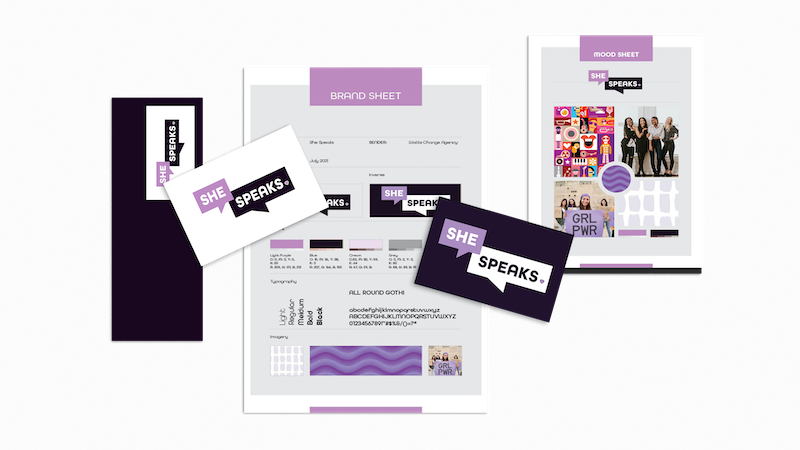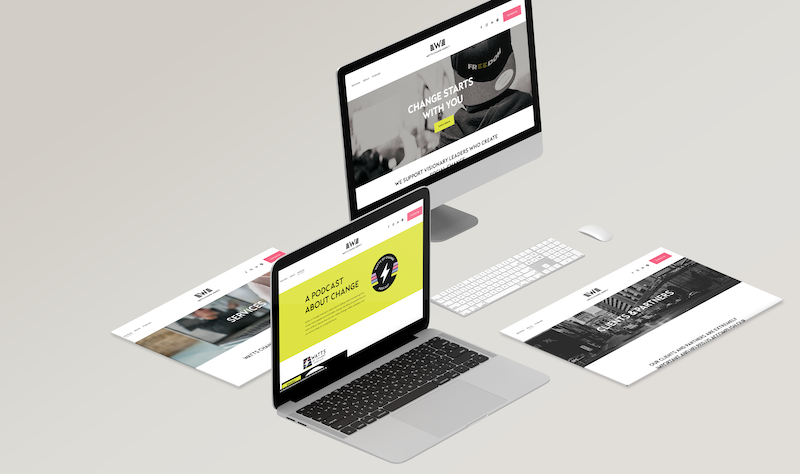How to Create a Consistent Brand Image
Develop a cohesive Brand Identity in six steps
Have you ever realized how quickly you can identify your favorite brands? Think of your favorite clothing brand. Can you quickly find this logo on your own clothing, or maybe its within your sight?
The brands we love have become embedded in our daily lives. We are constantly wearing, carrying, or looking at branded merchandise whether we are on our phones or physically walking around. Popular brands use very simplistic imagery and typography.
For example, Apple's logo is a simple, yet iconic design of an apple with a bite taken out of it. This logo has become so synonymous with the brand that it is instantly recognizable around the world.
Similarly, Nike's swoosh logo is a simple, yet powerful design that has become synonymous with the brand's message of athletic excellence.
Target's logo, which is a simple red bullseye, is an example of a successful and recognizable logo. The bullseye design is simple and bold, and it communicates the brand's message of providing a one-stop shopping experience.
Lululemon's logo is a stylized version of the letter "A" and resembles a person performing yoga. This logo communicates the brand's message of providing high-quality athletic wear for yoga and other fitness activities
To build brand recognition, brands must consistently present their brand to their target audience. Don’t believe me? Research shows that consistent presentation of a brand can lead to a 33% increase in revenue for brands.
Creating a consistent brand image across different platforms and channels is crucial for any business that wants to establish a strong and recognizable brand identity. With so many channels and platforms available today, it can be challenging to ensure that your brand is being portrayed consistently across all of them.
In this blog, we will discuss some tips on how to create a consistent brand image across different platforms and channels.
1.Define your brand
The first step in creating a consistent brand image is to define your brand. This means understanding your brand's values, personality, and tone of voice. It also involves identifying your target audience and understanding their needs and preferences.
Defining your brand is a crucial step in creating a strong and recognizable brand identity. Here are some steps to help you define your brand:
Identify your mission and values: Start by identifying your mission and values. Your mission statement should clearly articulate your company's purpose, while your values should define the guiding principles that govern how you operate. These are the foundations upon which you will build your brand.
Know your target audience: Understanding your target audience is critical to creating a brand that resonates with your customers. You should have a clear picture of who your target audience is, including their demographics, preferences, and behaviors.
Identify your brand attributes and unique selling proposition: Your unique selling proposition (USP) is what sets your brand apart from your competitors. Identify the key features and benefits that make your brand unique, and use them to differentiate yourself in the market.
Develop your brand personality: Your brand personality is the way you want your brand to be perceived by your customers. This includes the tone of voice you use, the emotions you want to evoke, and the values you want to embody.
Create your brand story: Your brand story is the narrative that defines your brand. It should explain how your company was founded, why it exists, and what its mission is. A compelling brand story can help customers connect with your brand on an emotional level.
Audit your brand: Conduct a brand audit to assess how your brand is currently perceived by customers. This includes reviewing your brand assets, messaging, and customer feedback. Use the insights gained from your audit to refine your brand identity.
Understanding your target audience is critical to creating a brand that resonates with your customers.
2. Develop brand guidelines
Once you have a clear understanding of your brand, you should develop brand guidelines. These guidelines should include your brand's color palette, typography, logo usage, and any other design elements that are unique to your brand. This will ensure that all your visual content is consistent and recognizable.
Developing brand guidelines is an important step in creating a consistent brand image across different platforms and channels. Here are some steps to help you create your brand guidelines:
Identify your brand assets: Your brand assets are the visual elements that make up your brand. This includes your logo, color palette, typography, imagery, and any other design elements that are unique to your brand. Make a list of all your brand assets and ensure that they are consistent with your brand identity.
Define your logo usage: Your logo is a crucial part of your brand, and it should be used consistently across all platforms and channels. Define the usage guidelines for your logo, including its size, placement, and color variations.
Establish your color palette: Your color palette should be consistent with your brand identity and should be used consistently across all platforms and channels. Define the primary and secondary colors that you will use, as well as any color variations and usage guidelines.
Choose your typography: Your typography should be consistent with your brand identity and should be used consistently across all platforms and channels. Choose a primary and secondary font that is in line with your brand identity, and define the usage guidelines.
Define your imagery style: Your imagery style should be consistent with your brand identity and should be used consistently across all platforms and channels. Define the types of imagery that you will use, as well as any usage guidelines.
Create a tone of voice guide: Your tone of voice is the way you communicate with your audience, and it should be consistent across all platforms and channels. Create a guide that defines your brand's tone of voice, including its style, language, and messaging.
Create a style guide: Once you have defined your brand guidelines, create a style usage guide that outlines how they should be used across all platforms and channels. This guide should include examples of how to use your brand assets, typography, color palette, imagery, and tone of voice.
Developing brand guidelines is essential for creating a consistent brand image across different platforms and channels. By defining your brand identity, identifying your brand assets, establishing your logo usage, choosing your typography, defining your imagery style, creating a tone of voice guide, and creating a usage guide, you can create a set of guidelines that will ensure your brand is consistent and recognizable.
Define the usage guidelines for your logo, including its size, placement, and color variations.
3. Use the same brand voice
Your brand's voice is the way you communicate with your audience. It is the tone and style of your messaging, and it is essential to maintain consistency across all platforms. Whether it is social media, email, or blog posts, your brand's voice should remain consistent, ensuring that your audience recognizes your brand wherever they encounter it.
Using a consistent brand voice is important in creating a strong and recognizable brand identity. Here are some steps to help you use a consistent brand voice:
Define your brand voice: This should be defined in the style guide you created in the steps above. Your brand voice is the way you communicate with your customers, and it should reflect your brand's personality, values, and mission. Consider the tone, style, and language you want to use in your communications.
Train your team: Once you have defined your brand voice and created a style guide, train your team on how to use it. Ensure that everyone on your team understands the guidelines for tone, style, and language, and how to use them in their communications.
Use consistent messaging: Ensure that your messaging is consistent across all of your communications. Use the same language and tone of voice in all of your marketing materials, social media posts, and customer communications.
Be authentic: While it's important to use a consistent brand voice, it's also important to be authentic. Your brand voice should be genuine and reflect your brand's values and personality. Avoid using a voice that feels forced or insincere.
Adapt to different channels: While your brand voice should be consistent across all channels, you may need to adapt it slightly to fit the context of each channel. For example, your tone of voice on social media may be more conversational than in a formal email.
Monitor and adjust: Monitor how your brand voice is received by your customers, and adjust as necessary. Listen to feedback and make changes to your brand voice if it's not resonating with your audience.
Using a consistent brand voice is important in creating a strong and recognizable brand identity. By defining your brand voice, creating a style guide, training your team, using consistent messaging, being authentic, adapting to different channels, and monitoring and adjusting as necessary, you can use a consistent brand voice to better resonates with your audience and build your brand.
Grammarly has a paid feature that will make sure your writing and messaging are all done to your style guide specifications.
4. Optimize your website
Your website is often the first place customers interact with your brand. So it’s important to optimize your website to align with your brand guidelines. Make sure that your website's design elements, color palette, and messaging are consistent with your defined brand guidelines.
Here are ways to add consistent branding to your website:
Use brand fonts, colors, logos, and design elements
Add your mission, vision, and values to your website
Tell your brand story in a video, podcast, or blog post
Use brand patterns as backgrounds and headers on your website
Hire a photographer to capture authentic pictures of you and your business
5. Maintain consistency ON social media
Social media is a great place for building brand awareness and engaging with your audience. It’s also a great place to get your brand offtrack. To maintain consistency across social media, make sure that your profiles on different platforms use the same profile picture, cover photo, and bio. Also, make sure that your content is consistent in terms of tone, style, and messaging.
Here’s some common issues brands run into on social media:
Inconsistent branding: Branding should be consistent across all social media channels. This includes the use of colors, logos, and messaging. Even photos shared on social channels should have similar lighting and colors.
Irregular posting: Posting irregularly or inconsistently can harm your credibility and make your brand seem unreliable. To avoid this, post regularly on social media channels and ensure content is consistent with your brand identity.
Inconsistent tone of voice: A brand's tone of voice should be consistent across all social media channels. If a brand's tone varies from one social media platform to another, it can confuse followers and create an inconsistent brand identity.
Inconsistent messaging: Brands should ensure messaging is consistent across all social media channels. This includes the language used in posts, captions, and comments. Stick to your brand positioning and messaging.
Lack of engagement: Brands should engage with their followers on social media by responding to comments, direct messages, and mentions. A lack of engagement on social media can make the brand seem unapproachable to its audience.
Misaligned content: Brands should ensure that their content aligns with their brand identity and values. Posting content that doesn't align with the brand can confuse followers and create an inconsistent brand identity. Also posting content too much and annoying users can be harmful to your brand.
Being inconsistent on social media can harm a brand's credibility and create an inconsistent brand identity. Brands should ensure that their tone of voice, branding, messaging, content, and engagement are consistent across all social media channels.
6. Monitor your brand's reputation
Maintaining a consistent brand image requires monitoring your brand online. Monitor your brand's mentions, reviews, and comments on social media and other platforms. Address any negative comments promptly and ensure that your responses are consistent with your brand's voice and messaging.
Here are some steps to help you monitor your brand's reputation:
Set up alerts: Set up alerts for your brand name, product names, and relevant industry keywords using tools like Google Alerts, Mention, or Brand24. This will help you track what's being said about your brand online.
Monitor social media: Monitor social media channels for mentions of your brand, product, or service. This can help you track sentiment and identify potential issues before they become major problems.
Monitor review sites: Monitor review sites like Yelp, TripAdvisor, and Amazon for customer reviews of your products or services. Respond to negative reviews and try to resolve any issues that customers may have.
Monitor industry news: Monitor industry news and trends to stay informed about what's happening in your industry. This can help you identify potential threats and opportunities for your brand.
Use analytics: Use analytics tools to track engagement, sentiment, and reach across social media channels. This can help you understand how your brand is performing and identify areas for improvement.
Respond to feedback: Respond to feedback, whether it's positive or negative. This shows your customers that you value their opinions and are committed to improving your products and services.
Keep an eye on competitors: Monitor what your competitors are doing and saying about your brand. This can help you identify potential threats and opportunities and adjust your strategy accordingly.
Use Google Alerts to keep track of when your brand is tagged so you can manage your brand’s reputation.
Monitoring your brand's reputation is an ongoing process that requires regular attention and effort. By setting up Google Alerts, monitoring social media and review sites, staying informed about industry news, using analytics, responding to feedback, and keeping an eye on competitors, you can stay on top of your brand's reputation and ensure that your brand is perceived positively by your target audience.
Creating a consistent brand image is essential for building a strong and recognizable brand. By defining your brand, developing brand guidelines, using the same brand voice, optimizing your website, maintaining consistency across social media, and monitoring your brand's reputation, you can create a consistent brand image that will resonate with your audience and help your business succeed.
Need help planning your brand? Download our free brand planning workbook for a step-by-step guide to creating your own brand.
Are you redesigning your brand, but don’t know where to start? We can help! Contact us for your next brand design project.







